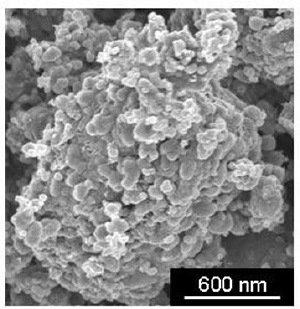Aug 2 2008
Why does lithium iron phosphate, a candidate for use in future lithium batteries, conduct electricity despite being an insulating material? Chemists at CNRS , working in collaboration with a team from CEA-Liten, have shed light on this paradox. Their experimentally verified “domino-cascade model” shows that local stresses within the material allow electrical and ionic conduction to spread from one area to the next, making the battery function. These results, published in the August issue of Nature Materials, open new horizons in the search for improved battery electrode materials and help explain how tomorrow's electric car batteries work.
 The lithium iron phosphate nanoparticles (100 nm) making up the agglomerate are individually transformed though the "domino cascade process" as the battery is charged.
The lithium iron phosphate nanoparticles (100 nm) making up the agglomerate are individually transformed though the "domino cascade process" as the battery is charged.
Lithium-ion batteries, which store three to four times more energy per unit mass than traditional batteries, are now used extensively in portable electronic devices (computers, cell phones, MP3 players, etc.). The positive electrode materials in these batteries are highly effective but too expensive to be used in the large batteries needed for electric vehicles and second generation hybrid vehicles. In the future, these applications may rely on lithium iron phosphate: it is environmentally friendly and has exceptional properties combined with low cost and good thermal stability (important for safety reasons). All these qualities make it the best candidate to be used in lithium batteries for future electric cars. However, this material does not have the ionic and electrical conduction properties needed to make the electrode work.
CNRS chemists from the Institut de chimie de la matière condensée de Bordeaux (ICMCB) and their partners from CEA-Liten became the first to explain this paradox. By studying lithium iron phosphate, they showed that the battery's charge-discharge cycles are made possible by a "domino cascade process." This phenomenon occurs as soon as stresses are present at the interface between the discharging material and the material in the discharged state. Electrical and ionic conduction is then extremely rapid in the interfacial zone, propagating from one spot to the next like dominos as the interface moves. The model has been verified by microscopic measurements.
This novel reaction process, resembling a wave sweeping through the crystal, explains how two insulating materials (one in the charged state and the other in the discharged state) can nonetheless make lithium-ion batteries function. These results are an important step forward in the quest for new low cost and safer electrode materials for future lithium batteries. The research has also made it possible to understand the processes taking place at the nanometer scale in lithium iron phosphate-based batteries, which may be used in tomorrow's hybrid and electric cars.
Notes:
- Institut de chimie de la matière condensée de Bordeaux, ICMCB, (CNRS / Université de Bordeaux / ENSCPB).
- CEA-Liten : Laboratoire d'innovation pour les technologies des énergies nouvelles et les nanomatériaux.
References:
- Lithium deintercalation in LiFePO4 nanoparticles via a domino-cascade model, C. Delmas, M. Maccario, L. Croguennec, F. Le Cras, F. Weill, Nature Materials, August 2008.
For more information on batteries, click here.